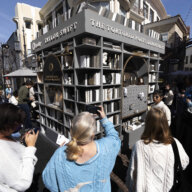
Conversations and debates about snow accumulation and early school dismissals has transitioned to the city’s generous distribution of rock salt.
“I think the city is not extremely efficient in the way in which they salt,” said City Councilman Jim Kenney. “They salt a day or so before the storm even hits and they lay down too much salt.”
Kenney requested council’s streets and services committee hold hearings to evaluate the city’s use of rock salt in its response to the recent winter storm saga.
The idea for the resolution grew out of conversations with dog owners, said the city councilman, “who were very upset with the fact that they have to thoroughly clean their dogs after taking them out,” he said. “If they lick it off and ingest it in could kill them.”
It also poses a danger to kids who play in the snow in the streets and on the sidewalks, he added.”And the other issue is the environment — what we’re putting in our water systems.”
Kenney asked if there was something else the city could be using. Hepointed to “beet juice,” which is made from a combination of salt brine and sugar beet molasses. The mixture’s sticky texture helps the salt brine cling to roads, bridges and sidewalks for a longer period of time.
“We’ve discovered things like ‘beet juice’ and other things and other additives that cut the salt content,” he said, “but still create the thermal necessary to melt the ice and snow.”
Kenney said other major cities that deal with large snow accumulations add sensors to service trucks which helps determine road and outside temperatures. Workers then distribute salt accordingly. “Those kinds of things I wish we were better at,” he said.
“It doesn’t happen often, years like this,” Kenney said. “But when it does happen, we have a ton of stuff we’re putting down.”
Mark McDonald, speaking on behalf of Mayor Michael Nutter’s administration and the streets department, acknowledged that when the temperature drops, rock salt loses its power.
“What we knew was that temperatures below 20 degrees or so. … the rock salt that we’re using does not perform very well,” McDonald said.
Even if the city used brine — a mixture of salt and water put on dry surfaces in anticipation of snow — in very cold temperatures, there is a dramatic loss of street-cleaning performance, McDonald said.
So the city hired an engineering firm to look at the de-icing materials and what would be appropriate going forward under the assumption that colder temperatures are expected in the future with anticipated climate changes.That report is not yet finished, McDonald said, but should be soon.
“If and when there is a hearing in council on this matter, the administration will be very receptive to talking about the issues,” he said.
McDonald added that in some cases you might need different equipment and storage spaces with new procedures and chemicals.
“Handling might be different with different products, and there might be an environmental tradeoff,” he said. “Clean streets comes with a cost.”
Kenney said the cost of any changes to the city’s snow removal policy would have to be considered.
“But there are certain things that we’ve used in the past over our history where we learned it was cancer-causing or bad for people and we stopped using it,” Kenney said. “I don’t think price is the sole issue, but we certainly want to look at it.”
The cost of snow
The city budgets a set amount specifically for snow removal. The money is primarily used for hiring contractors to supplement the work that is done by the streets department, according to Mark McDonald.
The city set aside $4 million this year, McDonald said. As of last week, the city has gone over budget, and is at about $4.3 million.
In an average year, the city’s streets department spends between $6 million and $8 million a year on snow removal.The city budgets $925,000 for salt.
“And we have adequate supplies for the foreseeable future,” McDonald said.





























